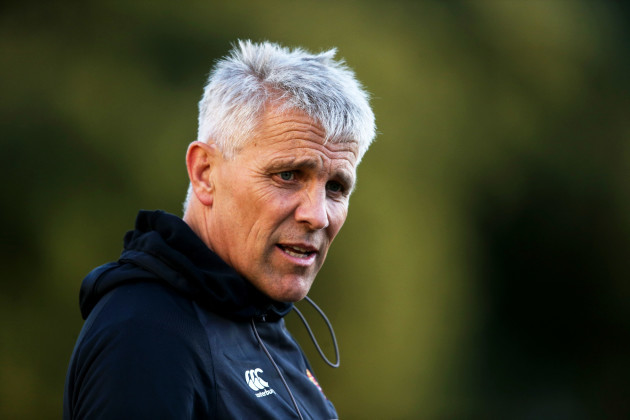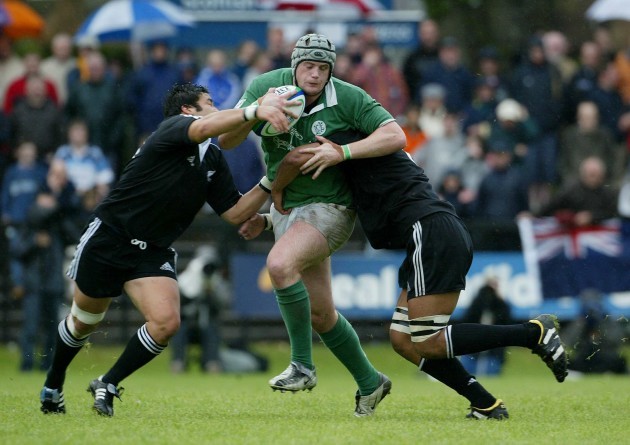“HUGH MAGUIRE WAS crying into his beer.”
In the early years of this century, when Munster and Leinster were still without a Heineken Cup and the All-Ireland League still had fresh memories of its heyday, Dublin University were building a formidable pack.
They forced their way up the rungs of the AIL ladder, reaping the benefit of having a powerful young number eight who was clearly destined to play at a higher level.
But such talents can never be held back and Ulster ensured Roger Wilson had a professional pathway back to Belfast when his time in Trinity came to an end.
“Actually, we’ve another pretty good guy coming through,” came the consoling words of Tony Smeeth to his long-serving DUFC forwards coach.
Before the avalanche of honours that decorated Jamie Heaslip’s career, it was Trinity which provided the platform for the Naas man to show off his undeniable talent and unbridled love for rugby.
Smeeth is director of rugby at College Park, a place Heaslip has expressed a fondness for as recently as his retirement-day statement. He was working hands-on with the club’s U20s when a star Irish schools forward came under his wing from Newbridge College.
“He was probably a bigger guy in Trinity than he was in the end,” Smeeth says of Heaslip, who was listed as 110kg ahead of his last season (as it turned out, a non-playing one) with Leinster.
“When he came to us he was probably 115, 118 (kg). He was very fleshy, a real country boy!”
Before the days of professional-like school setups preparing boys to explode into the Leinster Senior Cup and hit the ground running in the sub-academy, Heaslip bounced out of Newbridge without yet seeing a weights programme.
“It was kind of an old squash court that they put weights in. I remember being there and he had never lifted weights in school, it was all ball. But he did have that natural size — unusual size and speed for that time.
“Now it’s more normal - we’re producing them right through now, big athletic guys – but in those days it was unusual to have a guy of 115 kilos who could move like (Heaslip) could with the skill-level he had.”
In many ways, for anyone who tuned into Heaslip’s career late, it may be difficult to tally these lung-busting early days with the more quietly-effective, unsung-hero role Heaslip latterly settled into.
This week, in the days after his retirement, the plaudits came in the shape of stand-out moments like a tackle against Scotland or a try against Italy, but his true impact was that he was an absolute model of consistency. In his professional career, it was never one highlight-reel moment that told the tale of Heaslip; it was a thousand little differences made around the park.
Off the park too. It was a trademark of the Naas man that, even if he switched off from rugby, his commitment and work ethic pervaded every last aspect of his life. Rehab, the correct diet and rest were never optionals in his daily schedule.
Heaslip’s defining trait was his unflinching professionalism, but not until he was a professional.
“That definitely came later” Smeeth tells The42, but some aspects of his legacy were always there, such as his insatiable hunger to play more rugby. On the international stage, that was borne out by Heaslip playing the full 80 minutes on 72 of his 95 caps. Before the big stage, any stage would do.
“In those days, he was very much: ‘have boots, will travel.’
I remember we didn’t have a game one weekend and he really wanted to play. So he went to play with our seconds in Monkstown.
“He was U20 and was saying ‘I need to play some senior rugby. It was a J1 game on the back pitch in Monkstown. That was the type of guy he was, he just wanted to play. He wanted to play senior rugby against men.”
The irony of Jamie Heaslip’s first rugby outing after school would give you a pain in the face. Though, admittedly, not as much of a pain as the physical force of an elbow gave Heaslip on the windswept Holmpatrick field in Skerries.
Up until the closing minutes of the warm-up on the final weekend of the 2017 Six Nations, Heaslip was fortunate to escape much in the way of injury in his senior career. But running out for a first meaningful match with Dublin University U20s, Heaslip got his orbital bone in the wrong place at the wrong time, directly into the path of a back-swinging elbow from the second row he had just lifted in the line-out.
Smeeth was left cursing Murphy’s Law as his rough diamond was taken out of circulation for the first half of the season.
“He came in quite heralded, from Irish Schools and stuff. Of course he goes down injured in the first game!”
Early injury absence aside, over the course of four years, one at U20s, three as a senior, Smeeth and Trinity used Heaslip to devastating effect.
“He was just a difference-maker” Smeeth says with wistful nostalgia for the force of nature he once had at his finger tips.
“The big thing he had was that he was just fast. That’s why I think he was always able to step up: from 20s, to us, to Leinster, Ireland and the Lions. People don’t really credit him for being fast, but he could be ridiculously quick.”
“A bit like (Brian) O’Driscoll, and I’ve no worries about putting them in the same breath. When O’Driscoll came on the scene, he had this natural God-given pace and speed. Obviously great skill (too), which he kept, but then he changed his game to scoring tries from one metre out and he became more of a link player.
Jamie’s the same, especially in those early years, he could go 50 or 60 metres. I used to joke that he was like a Pacific Islander, because he had that skill level. He could offload and, because he had great feet, he was always in control of the contact. That’s the key to the offload really and he had it.”
“We’d get Jamie hitting the first ruck, then hold him in that outside channel. We’d go to the edge on the other side and then hit him on a line coming through.
“You’d have him coming in at 115 kg or whatever he was, he’d be hitting lines at angles and offloading. It was almost unstoppable. He’d carry the ball into three backs, offload it and we could walk it in the corner.”
That doesn’t sound like the same Jamie Heaslip who dominated the Ireland and Leinster number eight jersey until this time last year. It would appear that element of his skill-set was reined in by professional rugby. As Heaslip progressed, he was never far from a world-renowned ball-carrier like Rocky Elsom, then Sean O’Brien, Stephen Ferris or latterly CJ Stander.
To balance out the back row combination, Heaslip’s talents would primarily be set on the tight exchanges, rather than the loose. Yet while he was in the white of Trinity, he was off the bridle and free to rampage.
“I think Jamie went: ‘Okay, in this case, somebody’s gotta get over the ball,’” comes the theory from Smeeth.
“Someone has to be clearing the rucks. I don’t really remember that being part of his game. He was always a very good tackler. He’d dominate the collision and always be on top in the collision and always back to his feet quick.”
“He and Kieran Read have very similar skill-sets, but that’s been built through time.
“He was a ball-carrier, he was a runner.”
“It was a very good Trinity team. It was a very big pack and we had a lot of good players – big second rows in Martin Garvey and Mark Warburton. Jamie was on the back of those good club players. He was the icing on the cake.”
Clearly, Smeeth always recognised the quality, but it was the 2004 U21 World Cup when the lavish gifts possessed by Heaslip became absolutely crystal clear for all to see.
Thanks to Heaslip’s efforts, an Ireland team that featured Tommy Bowe, Denis Fogarty, Tomás O’Leary and Gareth Steenson dominated a semi-final clash with Australia (who were finalists in 2002, 2003 and 2005). In the final, however, they came up against a talented crop of Baby Blacks with Piri Weepu, Stephen Donald, Craig Clarke, George Naoupu, Ben Franks and Jerome Kaino all on board.
Kiwis have always been poor when it comes to naming talented opponents, but they’ve never been shy about identifying threats.
“I remember him beating Australia on his own in the semi-final. They just couldn’t stop him. In the final, New Zealand put up a high, high kick-off at the start. He caught the ball and their whole pack just ran over the top of him – which is the ultimate compliment really.”
Smeeth is in zero doubt that he and Trinity had the benefit of Heaslip for longer than was necessary. Leinster were eager to take him under their wing long before his final season in college, but were having trouble prying him from a more protective influence. The bump in the road for the professional outfit was one Colonel Richard Heaslip.
“His dad insisted he get his degree before he did anything and we were the benefactors of that.”
We played a wide open game at Trinity and that suited him. But I think we got way more off him than he got from us.”
Heaslip might well argue that particular point. There seems to be genuine affection in the way he mentions ‘the white of Trinity’ in a retirement statement which was not short on representative honours to squeeze into a few paragraphs this week.
Above, you’ll see an Instagram post of the field he dominated before turning pro; his caption, calling College Park his most cherished venue, strikes a chord for Smeeth.
“It was good to hear it, because I wasn’t always sure he felt that way.
“He was a little bit flippant. He’d come across as cocky if you didn’t know him, but he just had that inner confidence. He had that inner belief that he could do it. And I think he’s always had that ability to step up levels because he backed himself.”
Heaslip backed himself to the very end, Girvan Dempsey said this week, relentlessly working in an effort to rehab and stave off injury one last time. Whether Leinster’s UCD gym was eerily quiet or full of team-mates moving on without him, Heaslip remained a regular.
Six Nations, European Cups and Celtic League winner’s medals? He’s got three of each.
Throw another Challenge Cup, two Lions tours and 95 international caps on top of all that and you’ve got yourself a magnificently decorated career.
He retires with a war chest of medals and caps only comparable to O’Driscoll and Paul O’Connell.
Whenever Heaslip pulls the full collection together, he will always be reminded of his free-wheeling AIL days for DUFC, because the first medal in the collection is an U20 All-Ireland. Coincidentally, the landmark day for Heaslip was played at North Kildare Rugby Club, a supposed neutral venue midway between Trinity and Buccaneers. Having begun his season with a broken cheekbone, Heaslip ended with a title. He barely looked back.
“We won the All-Ireland U20s with him,” says the coach, a contented smile almost coming through the phone line.
“I remember him just being really, really giddy afterwards: ‘I’ve never won anything!’
“Jeez, he’s certainly won some stuff since.”



